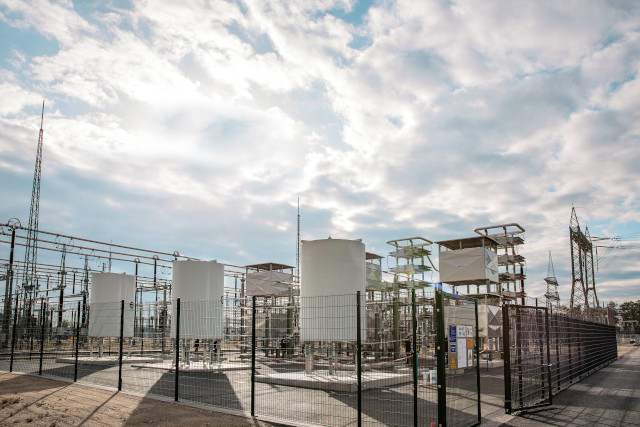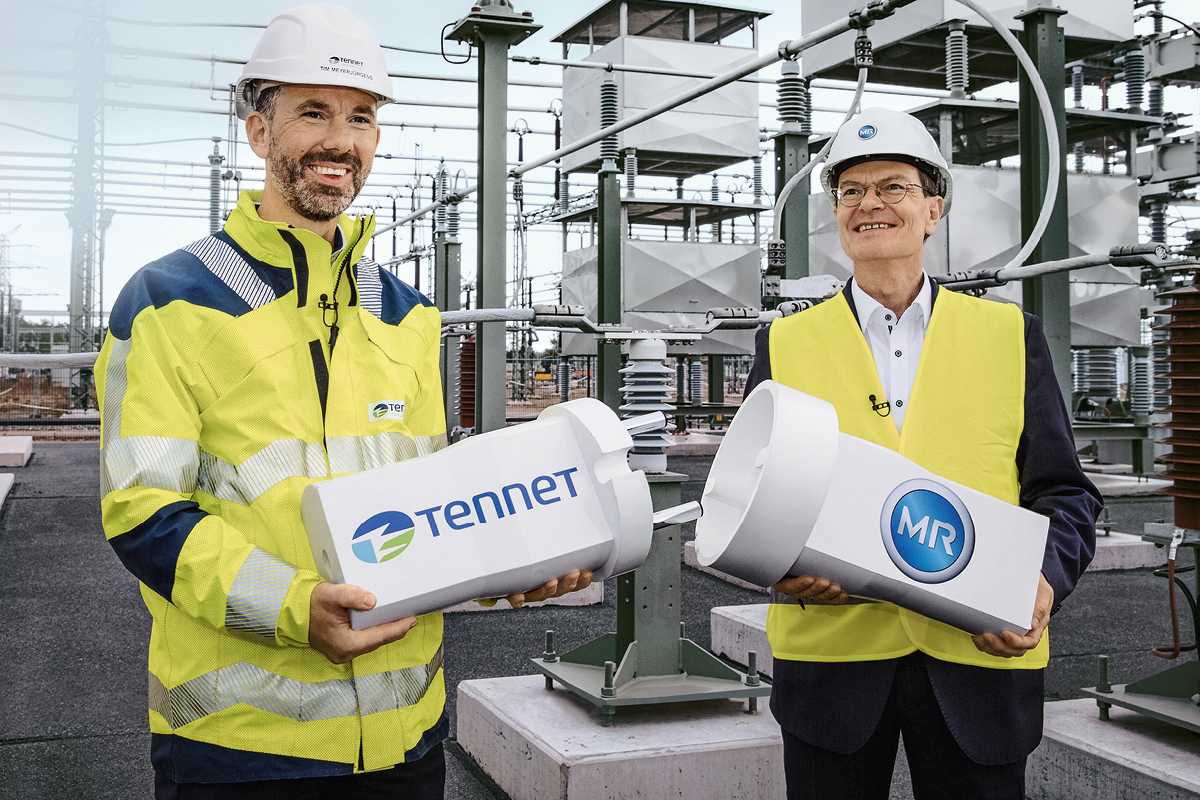No power plants, no reactive power? A new technology from MR makes it possible to provide it in substations: at extra-high voltage level.
Conventional power plants are shutting down, renewables are taking over — so where will grid-stabilizing reactive power come from in the future? A new technology from Maschinenfabrik Reinhausen makes it possible to provide it in substations. And it does so at the extra-high voltage level.
You don’t always recognize revolutions at first glance: At the Schwandorf substation, not far from MR’s Regensburg site, an oversized white plug is inserted into a socket on 6 October 2022. With this symbolic gesture, Tim Meyerjürgens, Managing Director of TenneT Germany, and Wilfried Breuer, Managing Director of MR, release the substation’s new MSCDN system for operation. What the guests see during the subsequent tour is part of the modernization plans for the substation, which transmits electricity from the extra-high voltage level to the distribution networks of the Upper Palatinate administrative district.
What the guests actually saw on this day is nothing less than a central key to ensuring grid stability for the energy transition. That’s because the MSCDN plant in Schwandorf solves a problem that has left many experts scratching their heads: Where will the stabilizing reactive power come from when more and more conventional power plants are shut down? Because without reactive power, most of which was previously produced by power plants, major problems arise. For example, when consumers all switch on the stove, washing machine and TV at the same time in the evening and plug the e‑car into the wallbox, they put a strain on the grid.
“MR also gets its power from this substation, so we’re doubly proud to contribute our experience here.”
Wilfried Breuer, Geschäftsführer Reinhausen
Additional reactive power from the power plants then balances out the grid voltage thus preventing outages. Decentralized generators like those in Feldheim or Niederbobritzsch (read about them starting on page 19) do play a part in creating a sustainable grid infrastructure. But if we consider the rising global energy demand and the time required for municipal, decentralized concepts, different technologies will be needed in the short and medium term to keep the grids stable in this transition phase. So who will provide the required reactive power?
Reactive power at all levels
This is what substations can do on their own with the help of an MSCDN system. MSCDN stands for Mechanically Switched Capacitor with Damping Network. When the load is high, the system provides capacitive reactive power, and when the load is low, it provides protection against overvoltage by automatically connecting and disconnecting the compensation system—which is already sufficient in many situations. “New operating equipment to replace the large rotating generators in the AC transmission grid is essential for the energy turnaround,” explains Thomas Brückner from MR’s Power Quality (PQ) business unit which plans and builds MSCDN plants together with OMEXOM. “Our PQ specialists in Erfurt have already installed these several times around the world and will also provide reliable support in the transmission grid,” says Wilfried Breuer.

This is because in recent years the experts have expanded the MR product portfolio and further developed the systems so that they can also withstand the requirements in the transmission network at high and extra-high voltage levels. Breuer: “As a result, we can already implement effective solutions for voltage regulation for three of the four German transmission system operators; such as here in Schwandorf, but also, for example, for Amprion at the Sechtem substation near Bornheim or for 50Hertz in Bad Lauchstädt.”
A substation for the future
As the largest of the four German transmission system operators, TenneT has already ordered three MSCDN plants from MR to modernize the grid infrastructure and ensure stability. The first of the three plants has started operation at the Schwandorf substation. It connects a total of four extra-high voltage lines with the distribution networks and is crucial for supplying the entire region. Thanks to the new plant, the region will be spared the scenarios that British regulators warned about in the media this year: that the collective boiling of water for five o’clock tea could soon provoke power cuts across the country.
“In implementing the energy transition, we also depend on innovative developments.”
Tim Meyerjürgens, Geschäftsführer TenneT
That’s why TenneT is planning even more modernization measures in Schwandorf. Tim Meyerjürgens, TenneT CEO, explains: “Every milestone helps us achieve the ambitious climate policy goals of Bavaria and integrate more renewables into the grid.” Because problems also arise on the other side when there is plenty of solar energy available in the sunny midday hours, but consumers do not need it. TenneT is investing around 68 million euros in the project—2.5 million in MR’s MSCDN plant alone. In addition, all switchgear and steel structures there will be successively dismantled and rebuilt, and the site area will be expanded by 3,500 square meters. These and other renovations will also help to transport regionally produced wind and solar power to the consumption centers.
REINHAUSEN INSIDE
The MSCDN system is designed as a C‑type filter circuit with divided capacitances and damping resistance. Its choke coils are designed so efficiently that they generate only low losses. The system can be phase-selectively activated via a special power switch. Complex dynamic systems such as the STATCOM (power converter) and static reactive power compensators (SVC) are used for stepless control.
Wind farms as power plants
Renewable generators will replace conventional power plants in their production of energy — but not in their function as providers of reactive power. At least not yet. Because in order to convert volatile generators into power plants, they would have to be coupled and equipped with a regulating head station, and connected to the grid core via a DC grid. Research projects are currently underway in this regard. Read in our Impulse how wind farms could become power plants.
Read more about wind farms as power plants in our impulse article.
Bavaria leads the way
TenneT is thus supporting the plans of the German state of Bavaria to be the first climate-neutral state in the German republic by 2040. Plans that go hand in hand with TenneT’s grid expansion projects, as Meyerjürgens reveals: “We at TenneT are aware of our responsibility and will therefore invest at least 60 billion euros in the energy transition by 2030.” Of this, 0.5—1.5 billion per year will be spent on grid expansion in Bavaria alone. Wilfried Breuer adds: “We are pleased to strengthen and continue our cooperation with TenneT TSO.”
The next MSCDN plants will soon be erected at Landesbergen in Lower Saxony and at UW Würgau in Bavaria where MR technology is also being used in new phase-shifting transformers (read more about this from page 34). So things are moving—and at all levels. “Until just a few years ago, the big players seemed quite hesitant, because although it was clear for many aspects of the energy transition “what” needed to be done, the technology for the “how” was still lacking in some cases or was still very cost-intensive,” explains Brückner. Breuer adds, “The more courageously we actively work together on the energy transition, the more innovations and new technologies will emerge precisely as a result and pave the way—like our MSCDN systems.”
YOUR CONTACT
 Do you have any questions about the project?
Do you have any questions about the project?
Thomas Brückner is there for you:
T.Brueckner@reinhausen.com
